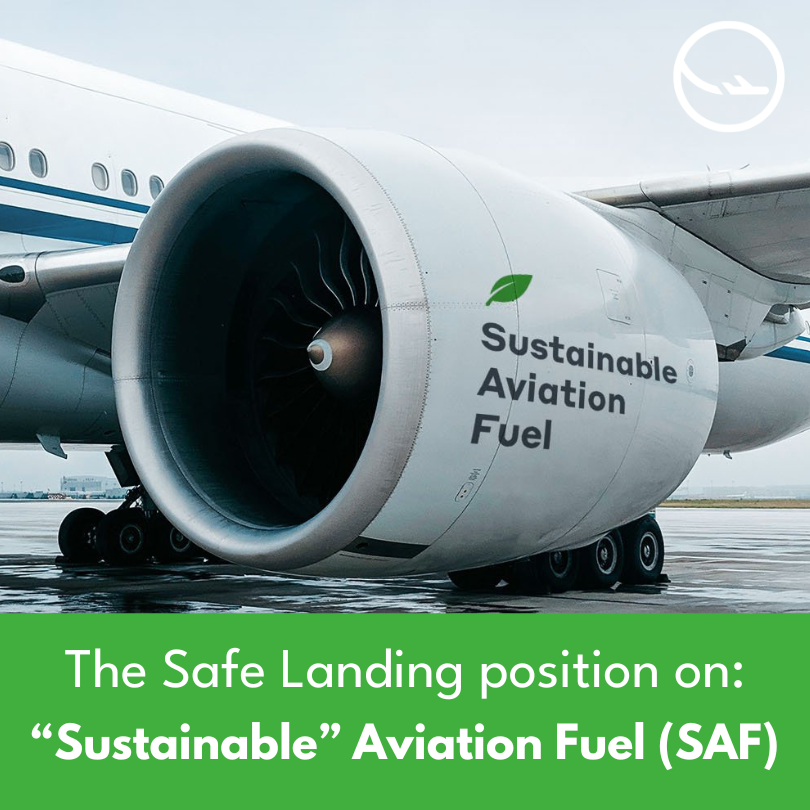What is “Sustainable Aviation Fuel”?
When we talk about Sustainable Aviation Fuels (SAFs) we are referring to either biofuels or electro-fuels (e-fuels).
Biofuels are fuels created from agricultural crops or from farm, forestry or municipal waste (e.g. food waste such as used cooking oil).
E-fuels, also called “power-to-liquid” (PtL), are fuels created using (ideally renewable) electricity to remove carbon from the atmosphere and combine it with hydrogen (from electrolysis of water) to create a hydrocarbon fuel.
Both types of fuel are created to substitute conventional jet fuel i.e., fossil fuel kerosene.
Is “SAF” an honest term?
An honest assessment of most SAF pathways reveal that they cannot be called fully sustainable, as they still have significant social and environmental impacts. Therefore, our group prefers to avoid use of the term ‘Sustainable Aviation Fuel’ or ‘SAF’ as it implies that any such fuel is by definition ‘sustainable’.
We advocate for the use of the term ‘Alternative Jet Fuel’ instead to refer to any drop-in alternative to conventional jet fuel. We believe this neutral wording does a better job at representing the reality of jet fuel technological developments.
But what are the realities of biofuels and e-fuels? Let’s dive a little deeper…
Biofuels
Whilst food, farm and forestry waste can provide a feedstock for biofuels, there simply isn’t enough of it to meet the current demand for fuel. Used cooking oil provides another feedstock, but again, there is only limited supply which can be more efficiently used in ground transport.
Crop-based biofuels face their own problems. There simply isn’t enough land available to produce the crops for biofuels, return our landscapes to nature and to feed a growing global population. These fuels would increase deforestation in a time when we should be reforesting and rewilding our land. Similar to the issues with animal agriculture, there would also be issues around land access rights and indigenous land sovereignty. Furthermore, biofuels have been shown to produce up to 3 times as much emissions than kerosene, mostly due to land-use change.
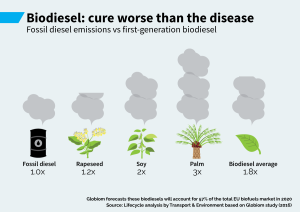
Crop-based biofuels can produce emissions up to 3x greater than fossil fuels
Animal fats are increasingly being used as a source of biofuel. This, however, poses a number of problems. Firstly, it would take away animal fats from other sectors, incentivising the use of palm oil. Secondly, supply of animal fats is very low and not something we want to increase. Thirdly, there is the risk that the use of waste animal fats will inadvertently increase demand for animal agriculture. We believe that the transition to sustainable aviation should go hand-in-hand with justice for all and that includes animals in the animal agriculture industry.
Finally, there are a number of proposed “SAF” facilities which aim to process municipal/city waste into jet fuel. Such “black bin bag” waste is usually a mixture of plastics and food waste. Clearly, plastic is produced from fossil fuel, and burning it still releases fossil carbon into the atmosphere:

Converting plastic waste into jet fuel is likely to lead to additional carbon emissions. Plastic waste should be reduced as a priority. Where it’s unavoidable, it effectively stores carbon over a long time period if it remains in a landfill.
Food waste contains many valuable nutrients which we should ideally return to the agriculture sector (via anaerobic digestors and composting) in order to maintain soil fertility, for growing more food. Failure to do this means that farms will need more synthetic fertilisers, produced from fossil fuels. Taking a holistic view, this may increase economy-wide emissions. This is why we need a cross-sector and cross-economy assessment of sustainable biomass resources at both a national and global level. We then need to prioritise those resources e.g. using a hierarchy of best use for the activities which provide the best environmental outcomes and maximise emissions reductions – rather than assume that our industry can appropriate a large fraction of global biomass for aviation.
Electro-fuels
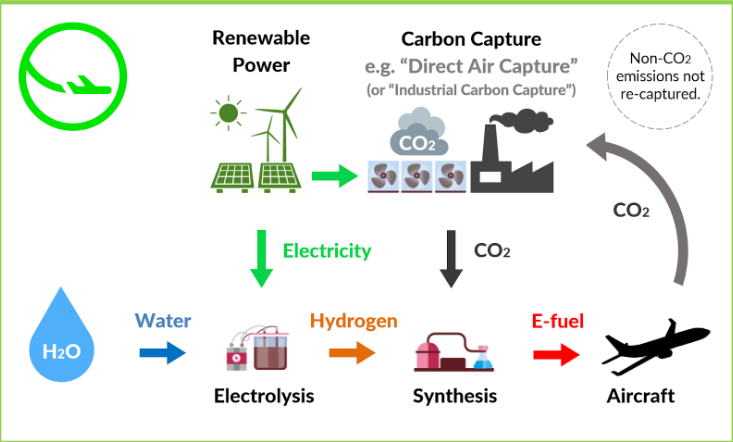
E-fuels face their own problems. Whilst they can reduce the overall lifecycle emissions of fuels, through Direct Air Capture (DAC) and the use of renewable energy to produce hydrogen from water, it is an incredibly energy-intensive and inefficient process and simply not scalable whilst renewable electricity is urgently needed to decarbonise other sectors.
For example, to produce enough fuel to meet 2018 demand for flying, the UK would need a large fraction of the entire UK national grid or twice the UK’s low-carbon energy currently available:
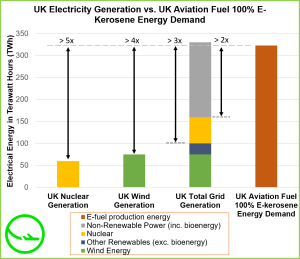
At a global level, a report produced by the aviation industry calculated (page 44) that in the most “efficient decarbonization” scenario where 40% of aircraft would be powered by liquid Hydrogen (LH2) and the rest (60% of aircraft) via synfuel by 2050, total energy demand would require 3-4 times the renewable energy produced globally today, or 20-30 times the renewable energy produced in Europe.
The UK Climate Change Committee state that:
“Given potential limits to the pace of deployment of low-carbon capacity, it will be important to focus on sectors which have the most efficient use of low-carbon electricity.
Across our scenarios new demands therefore come primarily from the electrification of transport, heat, and industry. Hydrogen production, Direct Air Capture, and synthetic fuels are relatively inefficient uses of electricity and should be lower priority than direct use of electricity for decarbonisation.” – UK Climate Change Committee, page 10
This relative inefficiency of producing synthetic fuels is illustrated by this graph from the CCC in the same report:
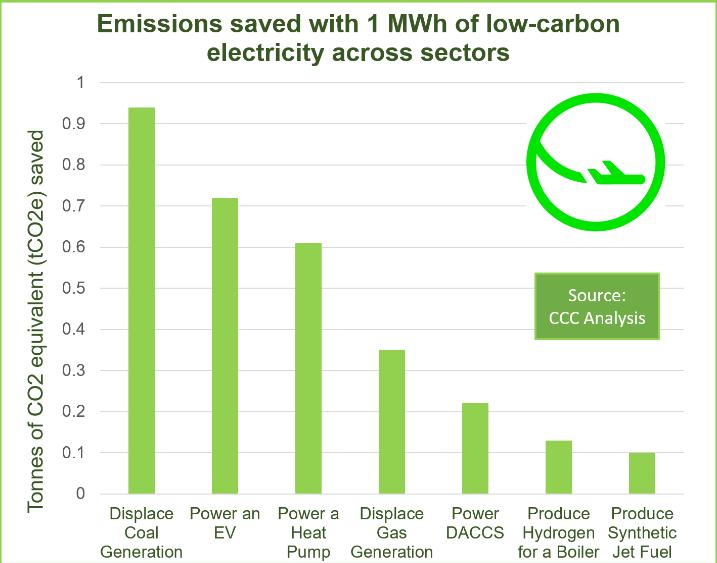
Adapted from Climate Change Committee, page 11
Therefore, while we still have fossil fuels supplying power generation, ground transport (combustion engines rather than electric vehicles [EVs]) and home heating (gas boilers rather than heat pumps), there are clearly better used for our limited supply of renewable electricity as this is scaled up over the coming decade.
E-fuels are also very expensive to produce and best estimates make it at least 3 times more expensive than kerosene (conventional jet fuel) even in 2050. The aviation industry tends to ignore this reality, and talk about these fuels without factoring in the severe cost increases into future projections for demand and air traffic growth.
They would also not completely reduce the non-CO2 and health impacts of aviation emissions.
Although reducing emissions through technology innovation is possible in theory, the academic consensus is that the inability to produce synthetic fuels on a large scale is a major obstacle.
A recent 2023 paper concluded that:
The scaling up of SAF to not only maintain but grow global aviation is problematic as it competes for land needed for nature-based carbon removal, clean energy that could more effectively decarbonise other sectors, and captured CO2 to be stored permanently. As such, SAF production undermines global goals of limiting warming to 1.5 °C; a conflict that is neither recognised in the roadmaps nor in the public debate.
Conclusion: navigating the realistic future of aviation fuels
Both biofuels and e-fuels can provide us with lower-carbon fuels for the future, but realistically biofuels are not scalable and e-fuels are too energy-intensive.
Alternative Jet Fuels are also a convenient distraction for industry leaders to not talk about dealing with fossil jet fuel and the need to address industry growth and demand management in the near-term. If we want to be able to fly at all in the future, we will need to address these issues immediately.
In the short-term we must focus on effective pricing of kerosene through an aviation fuel tax, or similar, and by introducing a frequent flyer levy so that the people that pollute the most, pay the most to fly.
We also should not ignore the likely massive costs and resource consumption of all Alternative Jet Fuel options. This is why ramping up the effective carbon price paid for aviation emissions needs to start immediately, and we should prepare for very high prices in the 2030s. This should also provide aircraft technology manufacturers with a policy signal to develop radically efficient aircraft designs, so that we can transport the maximum number of passengers, while minimising total resource use of whichever fuel is selected. Clearly all fuel production options are resource-intensive and will result in negative impacts, so we should minimise those impacts by minimising our total jet fuel or energy use as far as possible.

